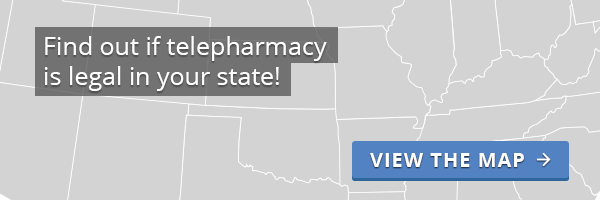Telepharmacy can be used wherever a patient — and your organization — can benefit from the expertise of a pharmacist.
Year after year, pharmacists are ranked among the most trusted professionals in the United States, even beyond the healthcare industry. Living and working in retail settings in local communities, pharmacists are also the most approachable and accessible member of the healthcare team. With their expertise on prescription drugs, medication-related side effects, and medication therapy management, it is evident that pharmacists are an essential piece of the patient-care puzzle.
Unfortunately, it’s not always possible for a pharmacists to physically be present in underserved communities. That’s where telepharmacy comes into play. As a refresher, telepharmacy is defined as “the provision of pharmaceutical care through the use of telecommunications and information technologies to patients at a distance,” according to the NABP.
How can we use telepharmacy to deliver better care in a variety of settings? Here are eight use cases or applications for telepharmacy, and how each benefits the patient.
1. Retail independent community pharmacy
Independent community pharmacies can maximize their pharmacists’ reach and capture more prescriptions through telepharmacy. Technology enables pharmacy owners to open retail telepharmacies as an extension of their current operation in order to serve more patients and provide better pharmacy access. Convenient access to a pharmacy and pharmacist can help positively impact medication adherence and further improve health outcomes.
Additionally, the remote dispensing business model can help prevent community pharmacies from closing. This article lays out the reasons why it may be a good idea to convert your struggling traditional pharmacy to a telepharmacy.
2. Hospitals and health systems
There is a great opportunity for hospitals and health systems to take advantage of telepharmacy to better serve patients. Remote order-entry review (inpatient) allows for 24-hour (think overnight and/or extended) pharmacy coverage at rural hospitals and clinics, while retail telepharmacy can be used in-house or as an extension of your outpatient pharmacy to clinics across the region. Health systems can provide access to specialists across the network by way of live-and-interactive video counseling (TeleCounselTM), allowing organizations to truly maximize resources. TeleCounselTM can also be used at the bedside or in the emergency room to provide patients with discharge medication and counseling before leaving the hospital.
Interested in learning more about retail telepharmacy in the hospital space? Read: 5 Reasons Why Outpatient Telepharmacy Makes Sense in Hospitals.
3. Specialty pharmacy
According to the NCPA, specialty is the fastest growing segment of the pharmacy industry. Healthcare organizations can use telepharmacy to benefit patients in oncology, HIV and Hepatitis clinics. A convenient on-site telepharmacy is an additional service organizations can offer specialty patients. Telepharmacy enables a residency-trained HIV pharmacist to consult patients in clinics across the network via live-video counseling. Specialists can ensure patients start their discharge medication immediately and educate them on why it’s important to stay adherent.
4. Mental-health centers
With the growing emphasis on mental health worldwide, pharmacists are well-positioned to play an important role in supporting patients with mental illnesses. Inserting a pharmacist into the mental health equation can help patients comprehend how important it is to take their medication as prescribed. Creating and fostering a patient-pharmacist relationship of this manner can help improve patient outcomes, and telepharmacy also allows for adherence-friendly point-of-care dispensing.
Mental health organizations can also connect specialists to clinics across the network via remote-video counseling. This connectivity allows organizations to maximize the use of its specialists and improve patient outcomes and quality of life.
5. Senior living centers
Independent living centers can also benefit from telepharmacy via on-site dispensing. Having a cost-effective telepharmacy on-site provides seniors immediate access to urgent medication. This type of remote dispensing site functions as a traditional retail telepharmacy, which is staffed by one (or more) certified pharmacy technician and managed by a remote pharmacist. Additionally, long-term care patients can benefit from remote-video technology via counseling sessions with pharmacists using tablets at their bedside.
6. Physician’s offices
Telepharmacy also allows you to virtually put a pharmacist in a physician’s office to focus on patient education and adherence. This is a win-win for both parties involved. Physicians are rated based on patient adherence, and it’s hard to ensure patients are adherent when they are filling their prescriptions elsewhere.
A retail independent pharmacy owner can team up with the physician and open a licensed telepharmacy site inside the doctor’s office. The telepharmacy owner will need to stock medication, acquire licenses and set up reimbursements as if the site was a traditional pharmacy. This application of telepharmacy is great for patients because they gain convenient access to a pharmacist and point-of-care dispensing.

7. Language barriers in healthcare organizations
Language barriers can prevent everyday people from accessing the care and prescription medication they need to live a happy, healthy life. In a world becoming more diverse by the day, telepharmacy software can help connect patients with healthcare professionals who understand precisely what’s wrong and how to fix it. Language barriers in healthcare are typically more urban than not, but this type of obstacle gives presents the same access-to-care struggles as a rural-based resident.
Currently, patients who can only communicate through ASL (American sign language) have access issues as ASL speaking pharmacists are few and far between. Interactive video counseling sessions also make it possible for sign language patients to access pharmaceutical care.
8. Employer campuses and schools
A relatively new application for telepharmacy, employer-based pharmacies are becoming more common because many large offices have thousands of people on site each and every day. Employer-based telepharmacies are not only cost-effective, but they help keep employees healthy, drive down sick days and help both the patient and company save on healthcare costs. The same can be said for school-based telepharmacies. The campus-based remote-dispensing site can provide prescription medication to students and teachers or professors.
On the subject of schools, have you enrolled in our free eCourse? The Telepharmacy Academy will teach you all about remote dispensing in two weeks! Sign up now!




